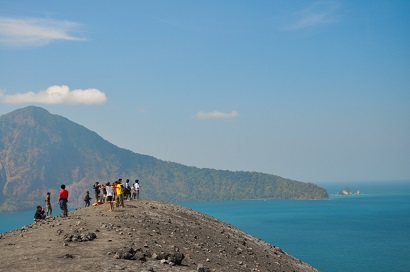A book by Simon Winchester in Krakatoa: The Day the World Exploded (2006) has described the atmosphere before and after the extraordinary eruption and tsunami from the activities of Mount Krakatoa in the Sunda Strait on August 27, 1883. This book is indeed very phenomenal and is widely used as a reference. related to the story of the eruption that affected the world's climate. From the book, this story is described again in a different way.
 |
| Mount Anak Krakatau is still active |
Entering the beginning of August 1883, the atmosphere of the Sunda Strait was already showing other conditions than usual, such as water waves that changed rapidly and were second to none. The sea water around Mount Krakatau shows movement and waves bobbing wildly, then at other times it can suddenly calm down like nothing happened.
An official at the head of the Dutch East Indies telegraph office, Schruit, in Anyer, a few days before the eruption had noticed the condition of the sea water around the Anyar beach. At that time he was taking lunch, after that he brought his food to the dining table on the outside veranda. then he observed the pillar of smoke and sea water around him. The movement of the sea water he felt was a bit strange, it made Schruit worried that something might happen. The first bad news that Schruit received was that his telegraph cable on the island of Java was broken by a falling pole.
In addition, there are stories from other places on the island of Sumatra, precisely in Katibung, South Lampung. A controller named Beyerinck also noticed the same thing. He was astonished when he saw the waves crashing around the Katibung pier.
Towards the day of the incident, there were several ships at sea around the Sunda Strait, such as the Loudon, Marie, and Charles Bal Ships. The sailors of these ships reported the sea conditions around the Sunda Strait, but this was deemed not to be a danger to their journey. Waves at sea are considered harmless, except when ships are near land.
As night fell, it turned out that the condition of the sea waves was getting fiercer. Beyerinck had time to watch the small boats being tossed about by the sea water and even spinning around.
It was near dawn and the sun was starting to turn a little red on August 27, 1883. What Beyerinck and Schruit had feared was starting to show evidence. Mount Krakatau is starting to show its eruptive activity. There were four eruptions that triggered the sea waves to move wildly and become more powerful.
Taken from another reference from the article entitled "Materials in Mechanical Extremes: Fundamentals and Applications (2013)", by Neil Bourne. At the time of the first eruption at 05.30 in the morning, and then followed by another large volcanic eruption a few hours later, it had triggered four large tsunami waves that hit the coasts around the Sunda Strait such as the south of Sumatra Island and the west coast of Java Island.
In his explanation Winchester in his book Krakatoa: The Day the World Exploded provides a description of sea waves that occur like giant balls that have an unimaginable devastating effect.
The large tsunami waves that occurred were described as high walls of water and moving unstoppably with a volume of water reaching hundreds of billions of tons rolling over everything in front of it accompanied by a tremendous roar.
Of the four eruptions the most powerful was the third at 10:02 am as noted by a Dutch colonial official, as did the tsunami waves that hit and annihilated everything in its path.
In the afternoon a few hours later, the volcanic activity of Mount Krakatau began to shower its surroundings with hot ash that flushed around South Lampung. This hot ash has killed no less than 1,000 residents in South Lampung, even on Sebesi Island which is very close to Mount Krakatau with a distance of only about 13 kilometers, this hot ash has destroyed the entire population of around 3000 people.
A colonel of the Dutch East Indies as in Kartono Tjandra in an article entitled The Four Deadliest Geological Disasters (2018), explained that more than 36,000 people had died in this volcanic tragedy. It even has an impact on the weather that is felt by residents in other parts of the world.
After that sad day, the volcanic activity of Mount Krakatau was still going on, but the intensity of the eruptions decreased, and the following days began to subside.
After the disaster, the world was dark due to volcanic ash spreading in the earth's atmosphere and the sun was closed for two and a half days, even Krakatoa's volcanic ash was visible in the skies of Norway and New York, United States.
The Indonesia Adventure
Reference :
1. Simon Winchester, The Day the World Exploded, 2006.
2. Neil Bourne, Materials in Mechanical Extremes: Fundamentals and Applications, 2013.
3. Kartono Tjandra, The Four Deadliest Geological Disasters, 2018.
Tag. : Simon Winchester, Krakatoa, tsunami due to the eruption of Krakatoa, Krakatoa, Mount Krakatoa, volcanic eruption,Krakatoa: The Day the World Exploded, Mount Krakatoa eruption, volcanic, tsunami waves, tsunami krakatoa